How and how to remove gel polish at home?

The gel polish owes its impressive durability to an insoluble plastic gel in combination with a regular polish. Due to the combination of these components, a gel manicure can last for at least two weeks, and at most a month, and without losing its glossy shine. Of course, this type of decorative coating requires timely partial or complete correction, but it is not always possible to do it with a nail master. In this regard, the question arises about the possibility of carrying out this procedure at home on their own. Let's find out what tools will help to solve this problem as efficiently and safely as possible for the health of nails.

Better ways
Nail service specialists have a negative attitude to self-removal of the gel coating at home in order to save time and money on visiting the salon. They argue that due to the use of unprofessional means or mechanical manipulations when removing gel polish, the nail plate may suffer. So, it is better not to risk it and remove it from professionals. Otherwise, the damaged nails will have to be treated and restored, so an attempt to save money on the contrary will lead to an increase in time and financial costs.

Such information often becomes a reason for women to think about whether to apply this beautiful long-lasting coating at all. After all, if you need to urgently remove it, then where is the guarantee,that at that moment there will be no problems with time for correction in the salon? In fact, with certain skills and knowledge, this material for manicure can be removed at home without negative consequences for the health of the nails. But it should be borne in mind that its removal is considered a much more time-consuming process compared to conventional varnish.

Gel tends to penetrate into the upper layers of the nail plate, which can be easily injured due to careless handling of instruments during mechanical removal. The use of low-quality products or a violation of the multi-stage technique for removing super-durable varnish can also have a detrimental effect on the condition of the nails.

So the masters are right in many ways. Therefore, before moving on to practice, you need to thoroughly study the theory: what, how, what and in what sequence you need to do.
Professional remedies
In the field of nail aesthetics, when creating a gel manicure, certain tools and special preparations are used, thanks to which the polymer coating stays firmly on the nails and looks flawless during wear. And what tools allow you to safely remove it and what are their features, we will find out further.
Remover
Masters of the nail industry remove gel polish and other artificial materials (tips, acrylic, biogel) with a liquid agent called remover. Its main advantage lies in its quick and delicate action. It effectively removes the decorative coating, dissolving it in 8-10 minutes and preserving the structure of the nail plate.

The liquid acquired a similar ability due to the content of caustic soda (sodium hydroxide) in an aqueous solution, which has a destructive effect on pigments of any complexity, and fruit glycolic acid, which has a lot of useful cosmetic properties. In particular, it has a regenerating ability and stimulates the mechanisms of cell renewal in the dermis.

The presence of oils (castor, argan) and vitamin E in the cosmetic product provides nourishment to the nails, contributes to their natural restoration. Conditioners take care of the beauty of the hands and maintain the normal moisture balance of the skin.


Removers work well with special reusable clothespins that are worn over your fingertips. Such clamps have great advantages over foil:
- provide a tighter pressing of cotton pads to the nails;
- reduce the duration of the coating removal procedure;
- eliminate tactile discomfort, as is often the case when soaking nails in foil;
- allow you to reduce the cost of purchasing an expensive remover due to its economical consumption.

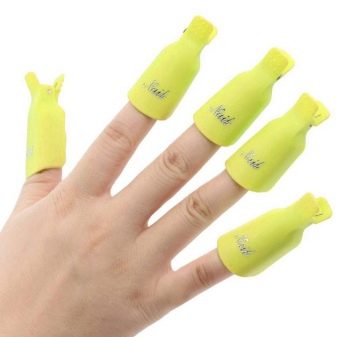
Steamer
Today, manicure specialists are actively using technological advances to remove artificial decorative coatings. Although no one has yet succeeded in developing a machine that can accurately paint nails, they have managed to create a smart assistant who can dissolve shellac. We are talking about a steamer - a unique device with exceptional advantages, which have already been appreciated by the masters of nail service and their clients.

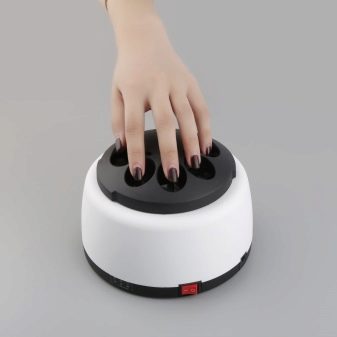
Advantages of a useful gadget:
- makes the process of removing any artificial coatings (gel polish, biogel, acrylic) fast, easy and convenient;
- allows you to do without the exhausting procedure of soaking nails with clothespins or foil caps;
- able to easily remove even the most complex gel polish designs;
- acts gently and does not injure the stratum corneum of the nail;
- has a clear and simple principle of operation, thanks to which it can be used not only in beauty salons, but also at home;
- makes it possible to save time and money on consumables for changing nail designs.
The device works similarly to a compress: the components of the artificial turf dissolve under the action of the vapors of the gel polish remover heated in the device.

How to use it correctly:
- we place the device on a stable flat surface;
- pour 60 ml of remover into a plastic tank and close with a lid;
- we connect to the power supply and wait for the sound signal informing about the readiness of the device for operation;
- we process the finishing top with a buff or a file;
- we lower our fingers into a row of holes, squeezing them in such a way as to exclude contact with the remover;
- the duration of the procedure is 5-15 minutes, depending on the type of coating;
- during the procedure, two beeps will sound, we remove the hand from the device after the device beeps a second time;
- take a pusher and get rid of the remains of gel polish.

It is recommended to store and use the remover in the device for a maximum of 3-5 days, depending on how often the device is used.
Milling cutter
The possibilities of hardware manicure - a simple, safe and, perhaps, the most effective of the existing methods of nail care, have been tested by thousands of women. In this case, the nail plates with the adjacent areas are processed with a special device - a milling cutter. Depending on the type of manipulation with the nails, the masters equip it with one or another replaceable attachment - ceramic or diamond cutters, which is very convenient, since the use of one device allows you to perform a wide range of manicure procedures.

This device is used for the following types of work:
- giving different shapes to the nail plates;
- removal of the cuticle and pterygium - a thin film at the base of the nail plate;
- deep cleaning of the lateral sinuses of the horny plates;
- polishing nails with / without leveling their surface before applying a decorative coating;
- removal of old decorative coatings, including those made of artificial materials.

According to nail masters, removing gel polish with a milling cutter by sawing is the most gentle way to get rid of this artificial material. When the active substances of the removers destroy the components of the gel, they simultaneously degrease and dehydrate the nail plate. When using a router, this does not happen, since the polymer material is cut only to the base layer, which implies direct contact exclusively between the router and the gel.

The choice of cutters depends on the level of training of the master. For beginners who are just learning the intricacies of working with this device, the best option would be ceramic cutters with a yellow line. Such a tool is the safest, since it does not heat up during operation and it is almost impossible for them to injure the skin.

In the working arsenal of the pros, as a rule, there are diamond cutters of low abrasiveness with a red edging and ceramic products of medium hardness with a blue line. The main criterion for selecting the shape of the tool is ease of use. Experienced craftsmen advise to give preference to cone-shaped or cylindrical nozzles, or those that are similar in shape to a corn cob.


The procedure for working with a router.
- We set the speed of the device. If ceramics are used, then we work at 10-15 thousand rpm, and when a diamond tool is used - at least 20 thousand rpm.
- When cutting the cover, we make long movements from the cuticle growth zone towards the edge of the nail plate.
- In the process of work, we do not stay at one point of the treated surface for more than a second and try to perform all manipulations with an even distribution of pressure.
- We cut off only artificial material, do not touch the nails. We work only up to the base layer, after seeing which we stop deleting.
- Having completely removed the decorative color layer, take a soft buff and polish the base.
- Apply nourishing oil to cuticles and nails.
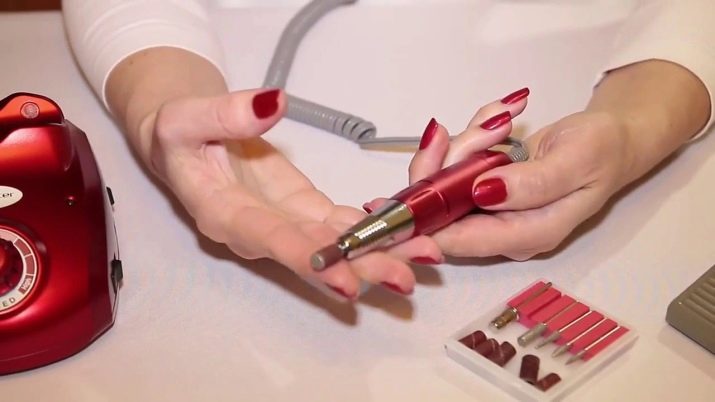
It is also worth mentioning here the use of files as an alternative to the router. Of course, this method is much more time consuming and takes a lot of time.However, ordinary files can also help get rid of gel polish at home, you just need to be patient.
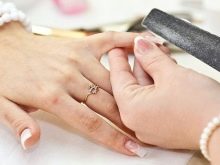

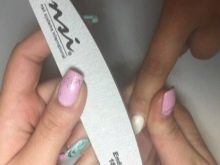
For work, you will need several nail files with an abrasiveness of 100-150 grit. They are used to shape nails made from artificial materials to the desired shape. In this case, the cover is also sawn down to the base layer. In order not to remove the excess, you need to regularly remove sawdust and use a cleanser to remove the sticky layer. The base is removed with a soft buff, and if it is left, then all exfoliated areas and uneven places are polished with it.



Acetone
This is one of the easiest and cheapest ways to remove gel polish without leaving your home. The main disadvantage of acetone is nail dehydration. The procedure is carried out exclusively using acetone-containing cosmetic varnish removers (LDSL) of the "Severina" type, and not an aggressive solvent for household needs.


Procedure:
- we take several small containers and fill them with acetone-based nail polish remover;
- we cut off the finish with a file with a degree of hardness of 100-150 grit;
- we treat the area next to the cuticle and the skin roller itself with a cream with a greasy texture, special oil or petroleum jelly;
- we lower our fingers in a container with liquid so that it completely covers the nails, and leave it to soak for 8-10 minutes.
The softened polymer coating is peeled off with orange sticks.



Gel polish can also be removed with special wipes that have already been impregnated with acetone. They can be ordered at specialty nail shops. The disadvantage of napkins is that to get rid of gel polish, in most cases, you have to take not one, but several attempts, plus they are also able to dry out the nail plates.


Each package contains individual sachets, and each of them, in turn, contains one lint-free napkin soaked in the active ingredient. The material from which the inner parts of the bags are made is similar to ordinary foil.
After cutting off the top layer of the coating and using a greasy cream to treat the skin around the nail plates, cut the bags from one edge and take out napkins, winding them around the nails. Then put the bags on your fingers and gently press them so that they do not fly off.
After 15-20 minutes, the condition of the gel-varnish coating is checked. If it remains on the nails, then they take an orange stick and pick it up. In case of failure, the process is repeated, pouring ZhDSL into the same bags, and then putting them on your fingers.


Vodka or alcohol
When there is no remover, a damaged gel manicure can be removed with vodka or alcohol. To dilute alcohol, use water in proportions 1: 2. Vodka is not diluted. Cotton pads are impregnated with any of these agents, applied to the nails and tightly wound over the foil to accelerate the destruction of the polymer material. After 15-20 minutes, the foil is pulled from the fingers in the same sequence as when laying on the nails. If the coating remains in place, the procedure is repeated. Mechanical manipulations are prohibited, as this can damage the stratum corneum of the nail.

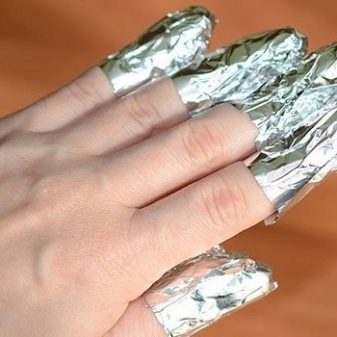
Preparation
To remove the shine, you need to damage the finish top with a buff or a soft file. Due to the violation of the integrity of the finish, the remover will be able to penetrate deeper into the "multilayer" gel-varnish manicure, and the duration of the procedure will be reduced. Since when applying gel polish, the tips of the nails are necessarily sealed, when it is removed, it is important to process them with a file, thereby "printing" the coating on the ends of the nail plate. All actions performed must be accurate and measured; excessive efforts are definitely not needed here.
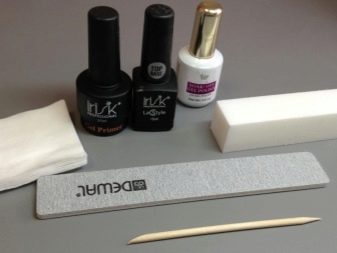

For subsequent hand washing, use neutral soap and warm water. Then the periungual rollers are lubricated with any of the available creams in order to reduce the aggressive effect of the active substance in the remover and to protect the skin.Otherwise, the liquid product may cause an unwanted reaction or severe redness of the skin. After that, they go directly to the very procedure for removing the coating.

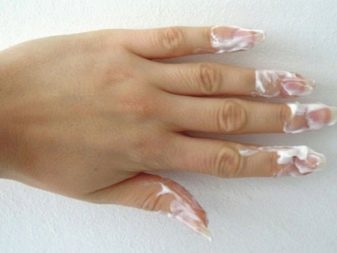
Withdrawal process
Let's consider step by step how to properly remove gel polish using standard technology using a remover or IDSL based on acetone.
For work you will need:
- cotton pads;
- nail files: buff for polishing gel polish on natural nails and a file with an abrasiveness of 180-240 grit;
- orange wood sticks;
- tear-off foil or special clips;
- cream with an oily and rich texture.





In salons, instead of cotton pads, craftsmen use special napkins, which are similar in structure and operational and technical characteristics to natural materials. But at the same time, wipes have additional useful properties - good air permeability and hygroscopicity, antistatic and hypoallergenic properties.

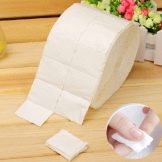


It is important that these products are made of a lint-free material, that is, after using them with gel and acrylic modeling, particles of threads do not remain on the nails. It is very convenient to wash the sticky dispersion layer from artificial coatings after polymerization in a UV lamp with napkins, to clean artificial or natural nails from gel polish, to degrease the nail plate. Another plus of napkins is economical consumption.


Sequencing.
- We cut out 10 pads from cotton pads that match the size and shape of the nails in order to minimize the harmful effects of aggressive substances of the solvent composition on the skin.
- We thoroughly impregnate the pads with a remover or ZhDSL, close the nails with them and wrap the foil on top or put on clothespins to prevent the evaporation of the active component.


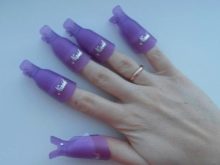
- Timing the time. To remove the polymer coating with a remover, you need to wait 8-10 minutes. If you remove it with an acetone-based product, then the waiting time is doubled.
- To speed up the process of soaking the gel, it is recommended to knead the foil on the fingers from time to time with light massaging movements.
- After the indicated time has elapsed, remove the foil or clothespin from one finger along with a cotton pad. Then we try to pick up and wipe off the softened polymer coating using a pusher or a wooden stick. To avoid delamination of the nail plate with the tool, we work only in the direction of its growth.

- We get rid of the remaining strips of foil or clothespins along with cotton pads and similarly remove the coating from other nails.

- If there are residues of gel polish after the procedure, we take a soft buff and carefully clean the problem areas.
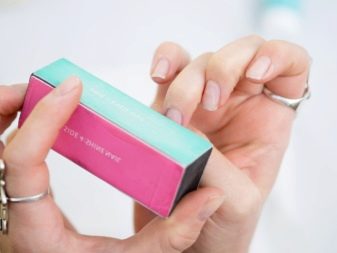

- We brush off the sawdust, wash our hands and treat the nails with a nutritious composition.
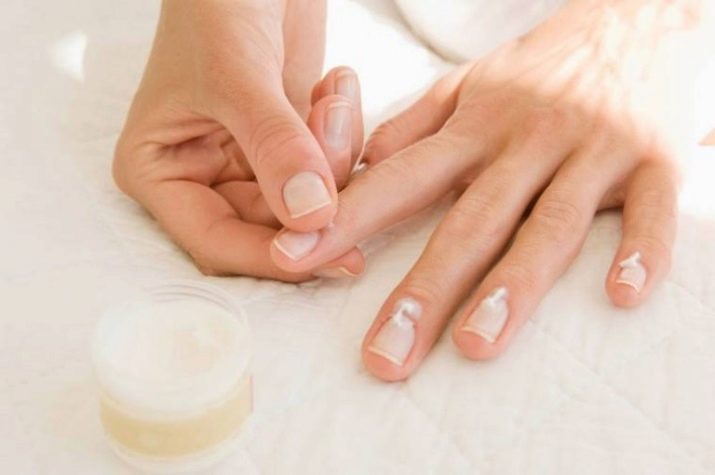
When using IDSL based on acetone, the procedure may not bring the desired result the first time, therefore, if necessary, repeat it.
Many fans of gel polish love the dazzling nail designs with rhinestones. Removing such nail jewelry is no more difficult than applying it. This can be done using a nail cutter with a sharp nozzle, for example, an umbrella-shaped one, or old manicure tweezers. In the first case, the pebbles are simply carefully pryed from below with a cutter, and in the second, the tweezers must be brought to the base of the rhinestone and slightly pressed.

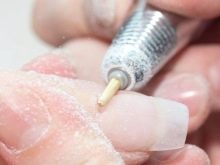

Both methods are simple and provide the same result: rhinestones easily slide off their places. After removing all the jewelry, the nails are treated with a top and the gel polish is removed using any of the methods described above.
Common mistakes
The use of gel polish alone cannot worsen the condition of the nails. But a violation of the technology for its removal can just lead to various negative consequences - a deterioration in the appearance and thinning of the nail plates.

Errors due to which nails most often suffer when removing the polymer coating.
- Incorrect cutting of the finishing top. Instead of removing the gloss from the nails, some beginners try to get rid of all the artificial material by affecting the top of the nail plate. Among them there are those who do not distinguish between base and natural nail due to the transparency of the base coat. As a result, the nails are cut off almost to zero.
- Using an iron pusher instead of orange sticks. This is a tool for experienced craftsmen. If it is used for cutting the top by those who are just getting acquainted with the manicure business, then in most cases such an experiment ends in failure. It is much easier and safer to remove the finish with a buff to the base coat, followed by soaking the rest with a remover. After that, it remains to take a soft wooden stick, which is simply not capable of damaging the nails, and remove the coating.
- Removal of insufficiently softened coating. If the material after soaking in foil or clothespins is difficult to remove, some continue to persistently clean it off and thereby injure the nails. Although you just need to hold the gel polish in foil or add a remover to soften the polymer coating to the maximum.
- The use of cheap, low quality products. After removing the gel polish coating with such preparations, the skin on the hands or fingers may begin to itch or itch a lot. For women with sensitive skin, allergies often develop, which are manifested by blisters or swelling of the skin.
Follow-up nail care
After removing the gel polish, the nails need comprehensive care, which consists in nourishing, strengthening and protecting them. To improve and restore the beauty of nails, you can use both store preparations and inexpensive home remedies.

Let's list the most popular ready-to-use nail strengthening products.
- Keratin masks with nourishing oils. Due to the content of keratin, the main building material that forms the nail plate, such preparations will become indispensable helpers in the fight for the restoration of severely damaged nails after removing the gel polish.

- Reinforcing coatings. The composition of such varnishes contains calcium, which increases the strength of nails, various vitamin and mineral compounds and proteins that solve the problem of their fragility, silk and Kevlar fibers, which form a protective barrier on the surface of the nail plate. There are also medicated colored varnishes. Their use allows you not to give up a beautiful manicure during the restoration of nails.

- Mineral pastes. Such funds have the ability to seal the exfoliated scales of the stratum corneum, promote the healing of microdamages, and restore shine and smoothness to the nails.

- Reducing oils. They contain tocopherol and pantothenic acid. These vitamins stimulate tissue regeneration, prevent splitting of nails, and activate their growth.

- Nutritious serums. Such systemic complexes with a balanced vitamin and mineral composition are used to solve a variety of nail problems.

You can use home remedies to tidy up your nails and cuticles.
Hand massage is best done with olive, burdock, castor, almond flaxseed oil. For nourishing masks, use jojoba and grape seed oil. The systematic use of oils softens, nourishes and rejuvenates the skin.

It is possible to strengthen and restore nails injured by aggressive active ingredients in the composition of IDSL based on acetone with the help of natural remedies.
- With oils. Castor oil, soybean oil and bergamot essential oil are mixed in a ratio of 7: 3: 1, and then the resulting mixture is heated in a water bath. Dip your fingertips into the bath, periodically massaging the skin around the cuticle. The duration of the procedure is 20-30 minutes.
- With sea salt. Warm water is poured into a small container, 30 g of pure sea salt is dissolved without aromatic fragrances or other impurities, and fingers are immersed in a medicinal solution. The duration of the procedure is 15-20 minutes.
After such baths, you need to thoroughly wipe your hands and cover your nails with a strengthening varnish with a vitamin and mineral composition.
How to remove gel polish at home, you will learn from the video below.








